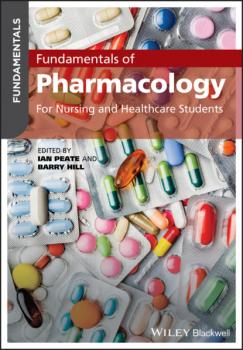Медицина
Различные книги в жанре МедицинаFundamentals of Pharmacology
All registered nurses must have a thorough understanding and a strong knowledge of pharmacology, medicines administration, and the ability to recognise and react to the effects of medicines. Fundamentals of Pharmacology helps nursing and healthcare students develop the skills and confidence required to apply the fundamental principles of pharmacology and to offer safe, competent and compassionate care. Concentrating on the medicines that students are most likely to encounter in real-world practice, this textbook provides concise coverage of pharmacology, essential medicines management principles, legal and ethical issues, drug formulations, analgesics, immunisations, and much more. Clinically focused chapters feature defined learning outcomes, multiple-choice questions, practical examples, and full-colour illustrations to aid readers’ comprehension of the complexities of pharmacology and care provision. The book utilises a straightforward, student-friendly approach to present ‘must-have’ information, with contributions from experienced clinicians and academics. Describes how to use pharmaceutical and prescribing reference guides Stresses the role and importance of compassionate care throughout Contains a full range of pedagogical tools which enhance learning and recall Aligns with current NMC Standards and Proficiencies for Registered Nurses and Nursing Associates Supplemented and supported by a wealth of online extras and resources Fundamentals of Pharmacology is essential reading for all nursing students, trainee nursing associates, post-registration nurses taking ‘nurse prescribing’ or ‘non-medical prescribing’ modules, and newly qualified nurses and nursing associates looking to better understand pharmacology.
An Illustrated Guide to Oral Histology
Learn more about the histological presentation of diseased and normal oral tissues with this high definition illustrated dental reference An Illustrated Guide to Oral Histology delivers a collection of high-definition histological and pathological images, presenting both diseased and normal oral tissues. The book provides over 200 high-magnification histomicrographs of oral tissues, as well as definitions and explanations of key identifying histological and pathological features of oral tissues. Readers will also benefit from explanations of the clinical significance of particular features, numerous images of ground sections, haemotoxylin- and eosin-stained sections, and electron images. It also includes core topics such as: An introduction to tooth development, including the bud, cap, early bell, and late bell stages A thorough exploration of enamel, dentin, cementum and dental pulp A discussion of the periodontal ligament, including alveolar crest fibers, horizontal, oblique, apical, and inter-radicular fibers, transseptal fibers, and gingival fibers A guide to alveolar bone, oral mucosa, and salivary glands Perfect for postgraduate dental students, An Illustrated Guide to Oral Histology will also be useful to undergraduate dental students, and those looking to improve their understanding of the microscopic structure of dental tissues and their pathologies.
Кого спасают первым? Медицинские и этические дилеммы: как решить их по совести и по закону
Кому должны достаться аппараты ИВЛ в критической ситуации, когда их всем не хватает? Стоит ли рассказывать родственникам пациента о причине смерти, если он просил скрыть ее? Приемлемо ли разрешать операции, намеренно калечащие человека, если он сам того желает? По поводу этих и многих других вопросов, сложных с точки зрения этики и медицины, размышляет автор, предлагая подумать и читателям. Причем не отвлеченно, а в контексте законов и морали, в которых мы все живем. Текст дополнен комментариями российского медицинского юриста Ангелины Романовской.
Кого спасают первым? Медицинские и этические дилеммы: как решить их по совести и по закону
Кому должны достаться аппараты ИВЛ в критической ситуации, когда их всем не хватает? Стоит ли рассказывать родственникам пациента о причине смерти, если он просил скрыть ее? Приемлемо ли разрешать операции, намеренно калечащие человека, если он сам того желает? По поводу этих и многих других вопросов, сложных с точки зрения этики и медицины, размышляет автор, предлагая подумать и читателям. Причем не отвлеченно, а в контексте законов и морали, в которых мы все живем. Текст дополнен комментариями российского медицинского юриста Ангелины Романовской. В формате PDF A4 сохранен издательский макет.
Внезапная сердечная смерть в жизни каждого
Сергей Михайлович Яшин – кардиолог, профессор, эксперт по хирургическому лечению нарушений ритма сердца. В своей книге он в доступной форме излагает современные представления о причинах, механизмах и способах профилактики внезапной сердечной смерти. Автор дает описание основных форм врожденных и приобретенных болезней сердца, их возможного участия в возникновении угрожающих жизни человека аритмий. Читатель узнает о методах оценки и модификации персонального риска внезапной смерти, а также о возможности коррекции и лечения ведущих факторов. Книга рассчитана не только на специалистов-медиков и студентов медицинских университетов, но может оказаться полезной и широкому кругу читателей.
Особый ребенок: исследования и опыт помощи. Выпуск 11
С 1998 года выходит в свет авторский периодический сборник РБОО «Центра лечебной педагогики» – «Особый ребенок». В десятом выпуске опубликованы статьи ведущих специалистов Центра и его партнерских организаций, представляющие разные формы работы с детьми и взрослыми, – ранняя помощь, групповые и индивидуальные занятия с дошкольниками, поддержка школьного обучения, подготовка к самостоятельному проживанию взрослых с психическими нарушениями. Издание адресовано специалистам (психологам, педагогам, дефектологам и др.), работающим с детьми и взрослыми с различными нарушениями развития, и всем, кто интересуется данной проблематикой.









